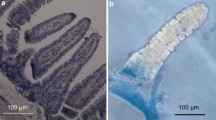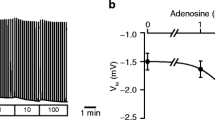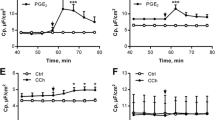Abstract
We have shown previously that secretagogues acting via the second messenger adenosine 3′,5′-cyclic monophosphate (cAMP) activate, besides their marked effect on the luminal Cl conductance, a K+ conductance in the basolateral membrane of colonic crypt cells. This conductance is blocked by the chromanol 293B. This K+ conductance is examined here in more detail in cell-attached (c.a.) and cell-excised (ce.) patchclamp studies. Addition of forskolin (5 μmol/1) to the bath led to the activation of very small-conductance (probably < 3 pS) K+ channels in c.a. patches (n = 54). These channels were reversibly inhibited by the addition of 0.1 mmol/1 of 293B to the bath (n = 21). Noise analysis revealed that these channels had fast kinetics and produced a Lorentzian noise component with a corner frequency (fc) of 308 ±10 Hz (n = 30). The current/voltage curves of this noise indicated that the underlying ion channels were K+ selective. 293B reduced the power density of the noise (S0) to 46 ± 8.7% of its control value and shifted fc, from 291 ± 26 to 468 ± 54 Hz (n = 8). In c.e. patches from cells previously stimulated by forskolin, the same type of current persisted in 3 out of 18 experiments when the bath solution was a cytosolic-type solution without adenosine 5′-triphosphate (ATP) (CYT). In 15 experiments the addition of ATP (1 mmol/1) to CYT solution was necessary to induce or augment channel activity. In six experiments excision was performed into CYT + ATP solution and channel activity persisted. 293B exerted a reversible inhibitory effect. The channel activity was reduced by 5 mmol/1 Ba2+ and was completely absent when K+ in the bath was replaced by Na+. These data suggest that forskolin activates a K+ channel of very small conductance which can be inhibited directly and reversibly by 293B.
Similar content being viewed by others
References
Bajnath RB, Augeron C, Laboisse CL, Bijman J, De Jonge HR, Groot JA (1991) Electrophysiological studies of forskolininduced changes in ion transport in the human colon carcinoma cell line HT29 cl. 19A: lack of evidence for a cAMP activated basolateral K+ conductance. J Membr Biol 122:239–250
Bleich M, Schlatter E, Greger R (1990) The luminal K+ channel of the thick ascending limb of Henle’s loop. Pflügers Arch 415:449–460
Burckhardt BC, Gögelein H (1992) Small and maxi K+ channels in the basolateral membrane of isolated crypts from rat distal colon. Pflügers Arch 420:54–60
Busch AE, Malloy K, Groh WJ, Varnum MD, Adelman JP, Maylic J (1994) The novel class III antiarrhythmics NE-10064 and NE-10133 inhibit IsK channels expressed in Xenopus oocytes and IKs in guinea pig cardiac myocytes. Biochem Biophys Res Commun 202:265–270
Cliff WH, Frizzell RA (1990) Separate Cl- conductances activated by cAMP and Ca2+ in Cl- -secreting epithelial cells. Proc Natl Acad Sci USA 87:4956–4960
Cook NS (1988) The pharmacology of potassium channels and their therapeutic potential. Trends Pharmacol Sci 9:21–28
Ecke D, Bleich M, Schwartz B, Fraser G, Greger R (1996) The ion conductances of dexamethasone-treated rat colonie crypts. Pflügers Arch 431:419–426
Gögelein H, Greger R (1986) A voltage dependent ionic channel in the basolateral membrane of late proximal tubules of the rabbit kidney. Pflügers Arch 407:S142-S148
Greger R (1994) Chloride channels of colonie carcinoma cells. In: Peracchia C (ed) Handbook of membrane channels. Academic Press, San Diego, pp 229–244
Greger R, Schlatter E, Wang F, Forrest JNJ (1984) Mechanism of NaCl secretion in rectal gland tubules of spiny dogfish (Squalus acanthias). III. Effects of stimulation of secretion by cyclic AMP. Pflügers Arch 402:376–384
Greger R, Schlatter E, Gögelein H (1986) Sodium chloride secretion in rectal gland of dogfish Squalus acanthias. News Physiol Sci 1:134–136
Greger R, Gögelein H, Schlatter E (1987) Potassium channels in the basolateral membrane of the rectal gland of the dogfish (Squalus acanthias). Pflügers Arch 409:100–106
Hamill OP, Marty A, Neher E, Sakmann B, Sigworth FJ (1981) Improved patch-clamp techniques for high-resolution current recording from cells and cell-free membrane patches. Pflügers Arch 391:85–100
Hansen CP, Roch B, Kunzelmann K, Kubitz R, Greger R (1993) Regulation of small and intermediate conductance outwardly rectifying chloride channels in HT29 cells. Pflügers Arch 424: 456–464
Hayashi T, Hirono C, Young JA, Cook DI (1995) The AChinduced whole-cell currents in sheep parotid secretory cells. Do BK channels really carry the ACh-evoked whole-cell K+ current? J Membr Biol 144:157 166
Ho K, Nichols CG, Lederer WJ, Lytton J, Vassilev PM, Kanazirska MV, Hebert SC (1993) Cloning and expression of an inwardly rectifying ATP-regulated potassium channel. Nature 362:31–38
Hunter T (1995) Protein kinases and phosphatases: the Yin and Yang of protein phosphorylation and signaling. Cell 80:225–236
Kerst G, Fischer KG, Normann C, Kramer A, Leipziger J, Greger R (1995) Ca2+ influx induced by store release and cytosolic Ca+ chelation in HT29 colon carcinoma cells. Pflügers Arch 430:653–665
Klaerke DA, Wiener H, Zeuthen T, Jorgensen PL (1993) Ca2+ activation and pH dependence of a maxi K+ channel from rabbit distal colon epithelium. J Membr Biol 136:9–21
Kubitz R, Warth R, Allert N, Kunzelmann K, Greger R (1992) Small conductance chloride channels induced by cAMP, Ca2+, and hypotonicity in HT29 cells: ion selectivity, additivity, and stilbene sensitivity. Pflügers Arch 421: 447–454
Leipziger J, Nitschke R, Greger R (1991) Transmitter-induced changes in cytosolic Ca2+ activity in HT29 cells. Cell Physiol Biochem 1:273–285
Lohrmann E, Greger R (1995) The effect of secretagogues on ion conductances of in vitro perfused, isolated rabbit colonie crypts. Pflügers Arch 427:494–502
Lohrmann E, Cabantchik ZI, Greger R (1992) Transmitter induced changes of the membrane potential of HT29 cells. Pflügers Arch 421:224–229
Lohrmann E, Burhoff I, Nitschke RB, Lang HJ, Mania D, Englert HC, Hropot M, Warth R, Rohm W, Bleich M, Greger R (1995) A new class of inhibitors of cAMP-mediated Cl- secretion in rabbit colon, acting by the reduction of cAMP-activated K+ conductance. Pflügers Arch 429:517–530
Nitschke R, Leipziger J, Greger R (1993) Agonist induced intracellular Ca2+ transients in HT29 cells. Pflügers Arch 423: 519–526
Petersen OH (1992) Stimulus-secretion coupling: cytoplasmic calcium signals and the control of ion channels in exocrine acinar cells. J Physiol (Lond) 448:1–51
Petersen OH, Findlay I (1987) Electrophysiology of the pancreas. Physiol Rev 67:1054–1107
Bleich M, Riedemann N, Warth R, Kerstan D, Leipziger J, Hör M, Van Driessche W, Greger R (1996) Ca2+-regulated K+ and non-selective cation channels in the basolateral membrane of rat colonic crypt base cells. Pflügers Arch (submitted)
Riordan JR (1993) The cystic fibrosis transmembrane conductance regulator. Annu Rev Physiol 55:609–630
Sandle GI, McNicholas CM, Lomax RB (1994) Potassium channels in colonic crypts. Lancet 343:23–25
Schmid A, Schulz I (1995) Characterization of single potassium channels in mouse pancreatic acinar cells. J Physiol (Lond) 484:661–676
Süßbrich H, Rizzo M, Waldegger S, Lang F, Lang HJ, Kunzelmann K, Ecke D, Bleich M, Greger R, Busch AE (1996) Inhibition of IsK channels by chromanols - impact on the physiological role of IsK channels in cAMP-mediated Cl- secretion of the colon. Pflügers Arch (submitted)
Van Driessche W (1994) Noise and impedance analysis. In: Schafer JA, Giebisch G, Kristensen P, Ussing HH (eds) Methods in membrane and transporter research. RG Landes, Copenhagen, pp 19–80
Yang Y, Sigworth FJ (1995) The conductance of minK channel is very small. Biophys J 68: A22
Author information
Authors and Affiliations
Rights and permissions
About this article
Cite this article
Warth, R., Riedemann, N., Bleich, M. et al. The cAMP-regulated and 293B-inhibited K+ conductance of rat colonic crypt base cells. Pflügers Arch — Eur J Physiol 432, 81–88 (1996). https://doi.org/10.1007/s004240050108
Received:
Revised:
Accepted:
Issue Date:
DOI: https://doi.org/10.1007/s004240050108




